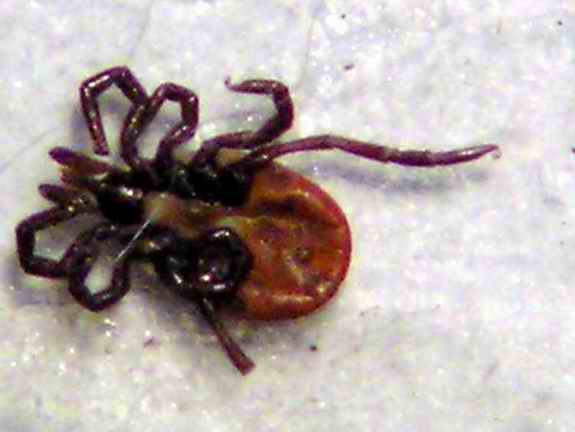|
Common Name: Black-legged Tick, Deer Tick, Bear Tick (Black-legged tick is the universal common name due to the stark contrast between the dark brown legs and the tan colored body; Deer tick is reference to its preferred adult host, the white-tailed deer; Bear tick is the common name in the Midwest) Scientific Name: Ixodes scapularis (Generic Ixodes is a New Latin word for the tick genus which is taken from the Greek word for birdlime or stickiness; Species from Latin scapula, meaning shoulder from an original word meaning shovel due to the use of the bone as a shovel, whence we get shoulder blade, referring here to the shape of the tick)
The black-legged tick is a three-host parasite with a two year life cycle. Eggs that are laid in the first spring hatch to become six-legged larvae in summer, reaching their peak activity in August. The larvae are very small, about the size of a poppy seed, and, as they are nearly translucent, below the visual threshold. The larvae attach primarily to small mammals such as white-footed mice and engorge with blood over several days. On satiation, they drop off and molt into the eight-legged nymph stage, to remain inactive through the first winter, emerging during the second spring.
Nymphs become active in May, climbing up on plants so that they are able to attach to medium size mammals such as raccoons, possums, and dogs to feed for several days and then drop off to molt into adults. Humans are suitable substitutes for the preferred hosts. This makes the nymphs a significant hazard, as they are nearly invisible and can go unnoticed long enough for the blood meal to be completed.
Adult ticks seek a third and final host through the remainder of the second summer, peaking in late September. They can climb up to three feet off the ground to attach to the preferred host, the white-tailed deer; humans and other mammals and birds are again acceptable substitutes. The female feeds for about a week while the male rarely feeds, seeking the deer host only to find a female. After mating, the female drops to the ground and lays about 3,000 eggs under the leaf litter at the end of the second summer to complete the two year cycle. If the adult tick is unsuccessful in mating, it will remain dormant in the leaf litter until temperatures begin to rise above 40 degrees F the following spring. The second peak of adult activity is in March.
Black-legged ticks are vectors for Lyme Disease. Although the disease was known in Europe in the late 19th century by a number of different names and in the United States by its symptoms for about 100 years, it was not until 1983 that it was linked to the black-legged tick in Lyme, Connecticut. In 1973, Andy Spielman, a prominent Harvard entomologist, sought to determine the etiology of a malaria-like illness called babesiosis on island of Nantucket. His quest led him to the white-footed mouse and subsequently to a tick that he named Ixodes dammini (for Gustave Dammin, a pathologist at Boston's Brigham and Woman's hospital and a landowner on Nantucket) as the cause. I dammini has since been officially determined to be the same as I. scapularis.
At about the same time, residents of Lyme Connecticut noticed an alarming outbreak of arthritis among young children. They enlisted the services of a rheumatologist from Yale named Allen Steere, who focused his epidemiological investigation not on the painful arthritic symptoms, but on the patients' recalling having gotten an unusual bull's eye shaped rash. This rash was known in Europe to be the symptom of a tick bite called erythema migrans. In 1977, one of his patients saved a tick that was subsequently identified as I. dammini. The true culprit was not isolated until five years later, when Willy Burgdorfer of the National Institutes of Health identified a helical bacterium called a spirochete as the source, which was eventually given the eponym Borrelia burgdorferi. Lyme Disease was declared by the CDC to be a nationally notifiable disease in 1991.
The black-legged tick is not the source of Lyme disease, but a vector that transmits it from an infected animal to an uninfected animal. The primary source of the disease is the white-footed mouse, the main food source for the larvae, which then molt to become infected nymphs. About 25 percent of all nymphs are infected with Lyme disease, the predominant source of human Lyme disease. About 50 percent of all adult ticks are infected with the disease. About 10,000 cases of Lyme disease are diagnosed annually.
Lyme disease has many variable symptoms that are frequently placed in three categories: early localized, early disseminated and late disseminated. Early localized is indicated by flu-like symptoms such as fever, chills and aching joints. The characteristic bull's eye rash only occurs in about half of all cases. Early disseminated occurs months later and is characterized by general fatigue and a variety of neurologic symptoms such as facial paralysis and cognitive problems. Late disseminated manifests over the course of years and may consist of chronic arthritis, profound fatigue and chronic neurological problems. |
